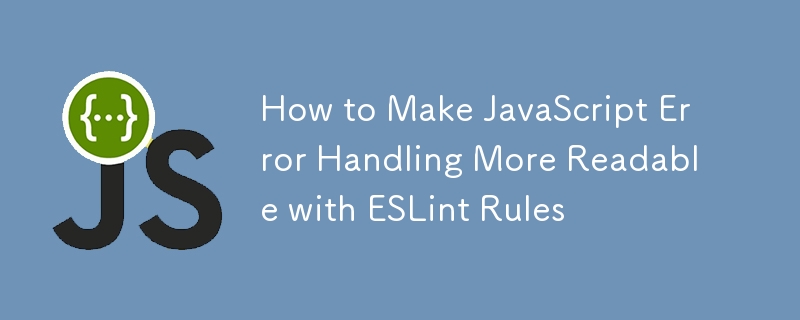ホームページ >ウェブフロントエンド >jsチュートリアル >ESLint ルールを使用して JavaScript エラー処理を読みやすくする方法
ESLint ルールを使用して JavaScript エラー処理を読みやすくする方法
- DDDオリジナル
- 2024-10-09 06:20:29519ブラウズ

はじめに: JavaScript でのエラー処理をマスターする
効果的なエラー処理は、堅牢な JavaScript アプリケーションにとって非常に重要です。これは、問題を迅速に特定し、デバッグを簡素化し、ソフトウェアの信頼性を高めるのに役立ちます。このガイドでは、ESLint による JavaScript エラー処理の改善について詳しく説明します。ESLint は、コードの品質を強化し、エラー処理方法を標準化するツールです。
なぜ読み取り可能なエラー処理に焦点を当てるのでしょうか?
読みやすいエラー処理により、問題に対する即座の洞察が得られ、開発者が問題を効率的に理解して修正できるようになります。この実践はチーム環境では不可欠であり、コードを長期的に維持するために不可欠です。
より良いエラー処理方法の実装
JavaScript エラー処理を強化するには、次の戦略を検討してください。
1. Try-Catch ブロックを効果的に使用する
try {
const data = JSON.parse(response);
console.log(data);
} catch (error) {
console.error("Failed to parse response:", error);
}
2. カスタムエラークラスの開発
class ValidationError extends Error {
constructor(message) {
super(message);
this.name = "ValidationError";
}
}
try {
throw new ValidationError("Invalid email address");
} catch (error) {
console.error(error.name, error.message);
}
3. 詳細なエラーログを確保する
function handleError(error) {
console.error(`${new Date().toISOString()} - Error: ${error.message}`);
}
4. 投球機能と非投球機能の区別
投げるバージョン:
function calculateAge(dob) {
if (!dob) throw new Error("Date of birth is required");
}
非スローバージョン:
function tryCalculateAge(dob) {
if (!dob) {
console.error("Date of birth is required");
return null;
}
}
ESLint によるエラー処理の強制
これらのプラクティスを強制するための ESLint のセットアップには、次の手順と構成が含まれます。
1. ESLint のインストールとセットアップ
npm install eslint --save-dev npx eslint --init
2. エラー処理用の ESLint ルールを構成する
効果的なエラー処理は、堅牢な JavaScript アプリケーションを開発するために不可欠です。以下は、コードベースで適切なエラー処理を強制するのに役立つ ESLint ルールです。
1. No Unhandled Promises
- Rule:
"promise/no-return-in-finally": "warn", "promise/always-return": "error"
- Explanation: This configuration ensures that promises always handle errors and don’t unintentionally suppress returned values in finally blocks.
2. No Await Inside a Loop
- Rule:
"no-await-in-loop": "error"
- Explanation: Awaits inside loops can lead to performance issues, as each iteration waits for a promise to resolve sequentially. It's better to use Promise.all() for handling multiple promises.
- Example:
// Incorrect
async function processArray(array) {
for (let item of array) {
await processItem(item);
}
}
// Correct
async function processArray(array) {
const promises = array.map(item => processItem(item));
await Promise.all(promises);
}
3. Proper Error Handling in Async Functions
- Rule:
"promise/catch-or-return": "error", "async-await/space-after-async": "error"
- Explanation: Enforce that all asynchronous functions handle errors either by catching them or by returning the promise chain.
4. Consistent Return in Functions
- Rule:
"consistent-return": "error"
- Explanation: This rule enforces a consistent handling of return statements in functions, making it clear whether functions are expected to return a value or not, which is crucial for error handling and debugging.
5. Disallowing Unused Catch Bindings
- Rule:
"no-unused-vars": ["error", {"args": "none"}],
"no-unused-catch-bindings": "error"
- Explanation: Ensures that variables declared in catch blocks are used. This prevents ignoring error details and encourages proper error handling.
6. Enforce Throwing of Error Objects
- Rule:
"no-throw-literal": "error"
- Explanation: This rule ensures that only Error objects are thrown. Throwing literals or non-error objects often leads to less informative error messages and harder debugging.
- Example:
// Incorrect
throw 'error';
// Correct
throw new Error('An error occurred');
7. Limiting Maximum Depth of Callbacks
- Rule:
"max-nested-callbacks": ["warn", 3]
- Explanation: Deeply nested callbacks can make code less readable and error-prone. Limiting the nesting of callbacks encourages simpler, more maintainable code structures.
8. Avoiding Unused Expressions in Error Handling
- Rule:
"no-unused-expressions": ["error", {"allowShortCircuit": true, "allowTernary": true}]
- Explanation: This rule aims to eliminate unused expressions which do not affect the state of the program and can lead to errors being silently ignored.
9. Require Error Handling in Callbacks
- Rule:
"node/handle-callback-err": "error"
- Explanation: Enforces handling error parameters in callbacks, a common pattern in Node.js and other asynchronous JavaScript code.
10. Disallowing the Use of Console
- Rule:
"no-console": "warn"
- Explanation: While not strictly an error handling rule, discouraging the use of console helps in avoiding leaking potentially sensitive error details in production environments and encourages the use of more sophisticated logging mechanisms.
3. Integrate ESLint into Your Development Workflow
Ensure ESLint runs automatically before code commits or during CI/CD processes.
Conclusion: Enhancing Code Quality with ESLint
By adopting these ESLint rules and error-handling strategies, you elevate the readability and reliability of your JavaScript applications. These improvements facilitate debugging and ensure a smoother user experience.
Final Thought
Are you ready to transform your error handling approach? Implement these practices in your projects to see a significant boost in your development efficiency and code quality. Embrace these enhancements and lead your projects to success.
以上がESLint ルールを使用して JavaScript エラー処理を読みやすくする方法の詳細内容です。詳細については、PHP 中国語 Web サイトの他の関連記事を参照してください。

